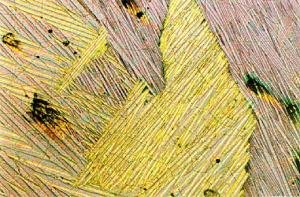The Changing Shape of New Materials

During the 1990-91 program at the workshop on Microstructure and Phase Transition, a great deal of interest was generated by a series of micrographs presented Donald Lord of Ford Motor Company. The micrographs display beautiful and mysterious domain patterns in the alloy Terfenol, which had been developed in the 1950's and found to exhibit magnetostriction, i.e., change of shape in response to a magnetic field.
The micrographs captured the attention of workshop participants R. James and D. Kinderlehrer, who began working on mathematical models for magnetostrictive materials that explained the observations. They noticed that there was excellent agreement with the experiment results if they assumed a kind of free energy that was then emerging in models of other types of phase transformations, namely a free energy with symmetry—related "energy wells," combined with terms accounting for magnetostatic energies. This insight immediately suggested a further step: if a material could be found which was both martensitic and also ferromagnetic properties, the theory indicated that it could be made to undergo much larger field-induced-strains than Terfenol. Their theory directly led, in the mid-1990s, to the discovery of a new family of alloys of nickel, magnesium, and gallium, which are now termed ferromagnetic shape memory materials or FMSAs. A decade later these materials have been developed to the point of exhibiting magnetic field-induced strains 100 times those of Terfenol, so that a magnetic field of less than 1 Tesla can induces shape changes of up to 10%.
An industry has grown around the production and use of such FMSAs. Many applications involve FMSAs as actuators in compact precision engineered instruments such as valves and pumps, for example in medical device applications, for latches, motors, and sonar transducers. FSMAs are also used in sensing, for example to detect magnetic fields or vibrations, and for passive energy absorption. Research in the field remains very active with entire conferences devoted to their study.